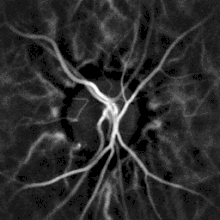Microangiography
Microangiography (/ˌmaɪkroʊˌændʒiˈɒɡrəfi/ MY-kro-AN-jee-OG-rə-fee)[1] is a type of angiography that consists of the radiography of small blood or lymphatic vessels of an organ. While most other types of angiography cannot produce images of vessels smaller than 200 µm in diameter, microangiography does just that.[2] A microangiographic image is the result of injection of a contrast medium into either the blood or the lymphatic system and, then, enlargement of the resulting radiograph. Thus, an image is obtained in which there is contrast between vessel and surrounding tissue. It is often used in order to detect microvascular lesions in organs. But, it has been suggested that microangiography can also be used to detect tumors through visualization of tumor-induced small blood vessels. This is because tumor growths require vascularization before they can develop more rapidly.[3] A few of the commonly used types are fluorescent, silicone rubber, and synchrotron radiation microangiography.
| Microangiography | |
|---|---|
| Purpose | radiography of small blood or lymphatic vessel |
Common types
Fluorescent microangiography
Also known as FMA, fluorescent microangiography is used to visualize and quantify changes in microvasculature.[4] It is different from other types of microangiography in that a fluorescent marker or contrast medium is used instead of something else. Fluorescein and indocyanine green are often used for this purpose.
Laser Doppler holography

Computational imaging with lasers, ultrahigh-speed cameras, commodity graphics cards, and state-of-the-art statistical filtering algorithms, emerges as a competitive alternative to dye angiographies. This class of non-invasive microangiography techniques can be advantageously applied to the eye fundus to reveal endoluminal blood flow profiles in the retina and choroid.[6] Laser Doppler imaging by holography provides high-contrast visualization of local blood flow in choroidal vessels in humans, with a spatial resolution comparable to state-of-the-art indocyanine green angiography.
Silicone rubber microangiography
This type of microangiography produces a three-dimensional image that depicts the distribution of vasculature in a tissue. It is commonly used to determine changes in microvasculature.
Synchrotron radiation microangiography
This type of microangiography uses monochromatic synchrotron radiation and a high-definition video system to provide an image of small collateral arteries with a diameter less than 100 µm.[2]
See also
- Angiography
- Computed Tomography Angiography
- Contrast Medium
- Intravenous digital subtraction angiography
- Radiography
- Laser Doppler imaging
References
- "microangiography." medical-dictionary.thefreedictionary.com. <http://medical-dictionary.thefreedictionary.com/microangiography>.
- Takeshita, Satoshi; Isshiki, Takaaki; Mori, Hidezo; Tanaka, Etsuro; Eto, Koji; Miyazawa, Yoshimichi; Tanaka, Akira; Shinozaki, Yoshiro; Hyodo, Kazuyuki; Ando, Masami; Kubota, Misao; Tanioka, Kenkichi; Umetani, Keiji; Ochiai, Masahiko; Sato, Tomohide; Miyashita, Hideo (1997). "Use of Synchrotron Radiation Microangiography to Assess Development of Small Collateral Arteries in a Rat Model of Hindlimb Ischemia". Circulation. 95 (4): 805–808. doi:10.1161/01.CIR.95.4.805. PMID 9054734. Retrieved 2009-06-10.
- "Micro-angiography for tumor vessel imaging" (PDF). Retrieved 2009-06-10.
- Bollinger A, Amann-Vesti BR (June 2007). "Fluorescence microlymphography: diagnostic potential in lymphedema and basis for the measurement of lymphatic pressure and flow velocity". Lymphology. 40 (2): 52–62. PMID 17853615.
- Puyo, Léo, Michel Paques, Mathias Fink, José-Alain Sahel, and Michael Atlan. "Choroidal vasculature imaging with laser Doppler holography." Biomedical optics express 10, no. 2 (2019): 995-1012.
- Puyo, L., M. Paques, M. Fink, J-A. Sahel, and M. Atlan. "In vivo laser Doppler holography of the human retina." Biomedical optics express 9, no. 9 (2018): 4113-4129.